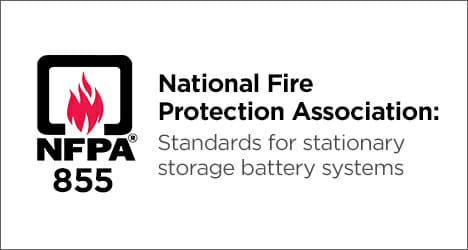Working with EPCs — End-to-End Renewable Energy Engineering Learn More
New standards on the horizon for battery storage

As the use of lithium-ion battery arrays for power storage on solar and other types of projects has grown, so has the call for clear fire safety guidelines covering their use. A recent incident in Arizona highlights the need. On April 19, 2019, four firefighters were hospitalized after an explosion at an Arizona Public Service facility that included battery storage. While the cause of the incident is unclear at this time, it is possible that lithium-ion batteries were involved.
Industry stakeholders were already working to address the need for more comprehensive fire safety standards covering battery arrays. The National Fire Protection Association (NFPA) published draft standards for stationary storage battery systems, NFPA 855, in 2018. The organization is accepting comments on the standards, which many expect to be adopted formally by 2020. In fact, the California Fire Code calls for using many of the draft standards within NFPA 855.
“At Blymyer Engineers, we appreciate the need for clear fire safety standards for stationary storage battery systems,” says Blymyer Engineers Director of Engineering Greg Mazur. “The effort comes at a good time in the industry because advances in lithium-ion battery technology have inspired more widespread use of energy storage. For instance, many of the distributed solar projects we’re working on at the moment include battery storage.”
He adds: “Like other industry participants, we’re interested in the results of the investigation into the incident in Arizona. Stationary storage battery systems are an important part of a more sustainable power grid. We hope to see insights gained from this investigation incorporated into any new NFPA standards.”
A quick look at a few changes
Blymyer Engineers has been following the development of the new fire standards closely, and our team is ready to help clients understand and comply with the evolving requirements for battery systems. NFPA 855 covers both indoor and outdoor stationary battery systems, and it aligns with many of the widely used standards contained in UL 9540, a set of standards published by a private organization in 2016.
The Blymyer team sees few game changers in NFPA 855 for projects already taking UL 9540 into account, but when taken as a whole, it could add complexity to some projects. This is especially true for battery storage systems installed in confined spaces. A new 3-foot spacing requirement between arrays should be accounted for early in the design process for buildings expected to include battery systems. There are also some additional requirements for large indoor systems.
“NFPA 855 adds clarity to fire safety requirements for battery systems,” says Greg Mazur. “As we see it, these requirements will only increase the move to include power storage on more projects. Project owners will enjoy more certainty around everything from spacing and security to fire suppression. With the industry taking advantage of the comment period now, we expect that the final version of NFPA 855 will further enhance battery system fire safety.”